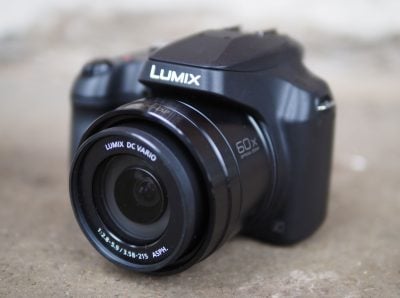Panasonic Lumix FZ80 / FZ82 review
-
-
Written by Ken McMahon
Quality
To compare real-life performance, I shot this scene with the Panasonic Lumix FZ80 / FZ82, using its best quality JPEG setting and at its 80 ISO base sensitivity setting. For this test the FZ80 / FZ82 was mounted on a tripod and image stabilisation was disabled.I set the Lumix FZ80 / FZ82 to Aperture priority mode and selected the widest available aperture which is f2.8. At its base sensitivity setting of 80 ISO the Lumix FZ80 / FZ82 selected a shutter speed of 1/2000.
Panasonic Lumix FZ82 quality at 20mm equivalent
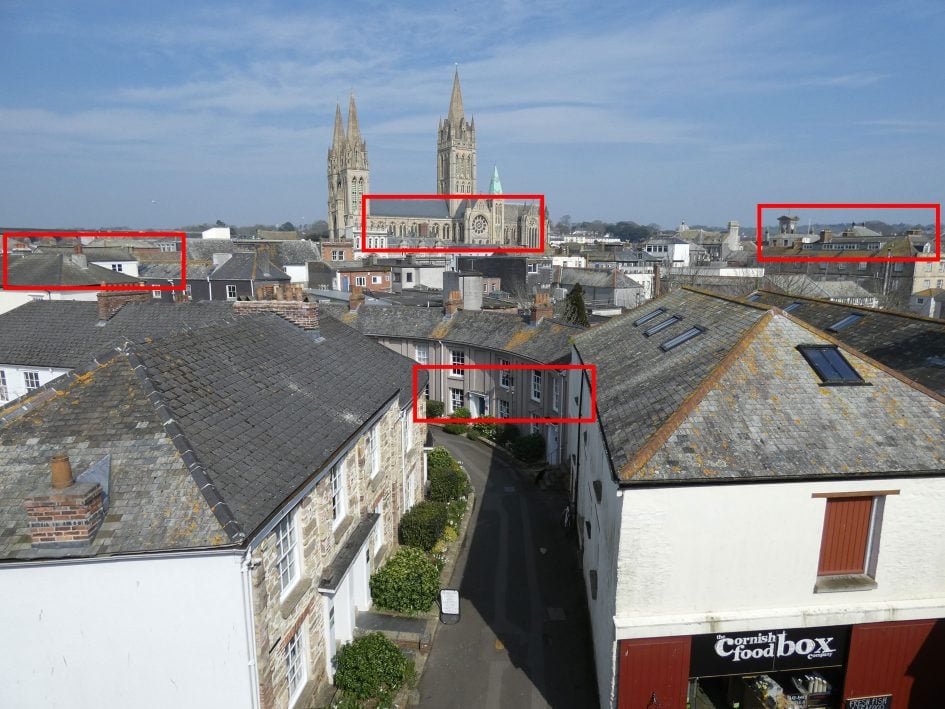
I’ve taken four crops from this image produced by the FZ80 / FZ82 at its 20mm maximum wide-angle setting – marked in red above. Overall, the first thing that strikes me is that they’re a little bit noisy. If it weren’t for the noise I’m sure the level of detail in all of these crops would have been better. As it is, the noise is quite noticeable in the first and last crops, and you can see speckling in the walls and around the street lamp in the third crop.
Noise aside, I think the overall quality of these crops is pretty good. There’s a little bit of distortion in the first and last crops from the centre of the frame, but at 20mm equivalent, and from a lens with a 60x optical zoom it would be remarkable if there weren’t. Aside from the slight sideways sloping of detail that you’d expect to be vertical and a little bit of colour fringing in the first crop, I think the FZ80 / FZ82’s lens puts in a pretty good performance at the edges at this focal length.
Crops two and three from closer to the middle of the frame don’t suffer from the edge issues and display a good level of detail with nice sharp edges. It’s just a shame that the noise is getting in the way of it being even better.

Above: Panasonic Lumix FZ80 / FZ82 JPEG f2.8, 80 ISO.

Above: Panasonic Lumix FZ80 / FZ82 JPEG f2.8, 80 ISO.

Above: Panasonic Lumix FZ80 / FZ82 JPEG f2.8, 80 ISO.

Above: Panasonic Lumix FZ80 / FZ82 JPEG f2.8, 80 ISO.
Panasonic Lumix FZ82 quality at 600mm equivalent
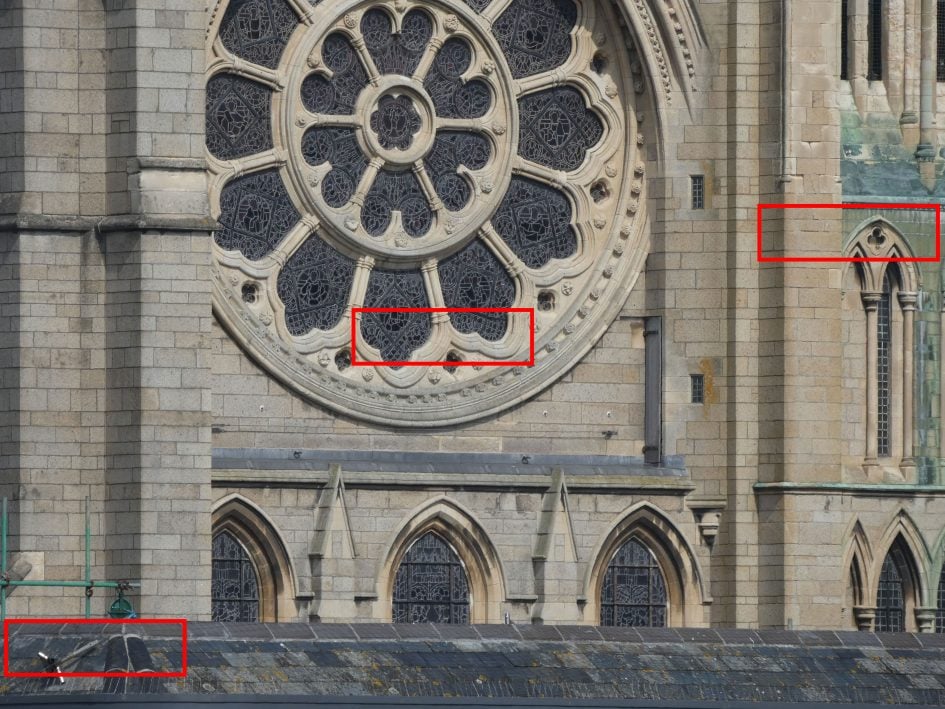
At the 600mm mid-way focal length I’ve taken three crops from this shot – as usual marked in red above – from the bottom left corner, the middle and the top right corner of the frame. The Lumix FZ80 / FZ82 actually does much better at the edges at this focal length with none of the distortion or chromatic aberration we saw at the 20mm equivalent wide-angle setting. Once again the edge detail is crisp and clean and the overall level of detail is good, but would’ve been better if it weren’t for the noise.

Above: Panasonic Lumix FZ80 / FZ82 JPEG f5.6, 80 ISO.

Above: Panasonic Lumix FZ80 / FZ82 JPEG f5.6, 80 ISO.

Above: Panasonic Lumix FZ80 / FZ82 JPEG f5.6, 80 ISO.
Panasonic Lumix FZ82 quality at 1200mm equivalent
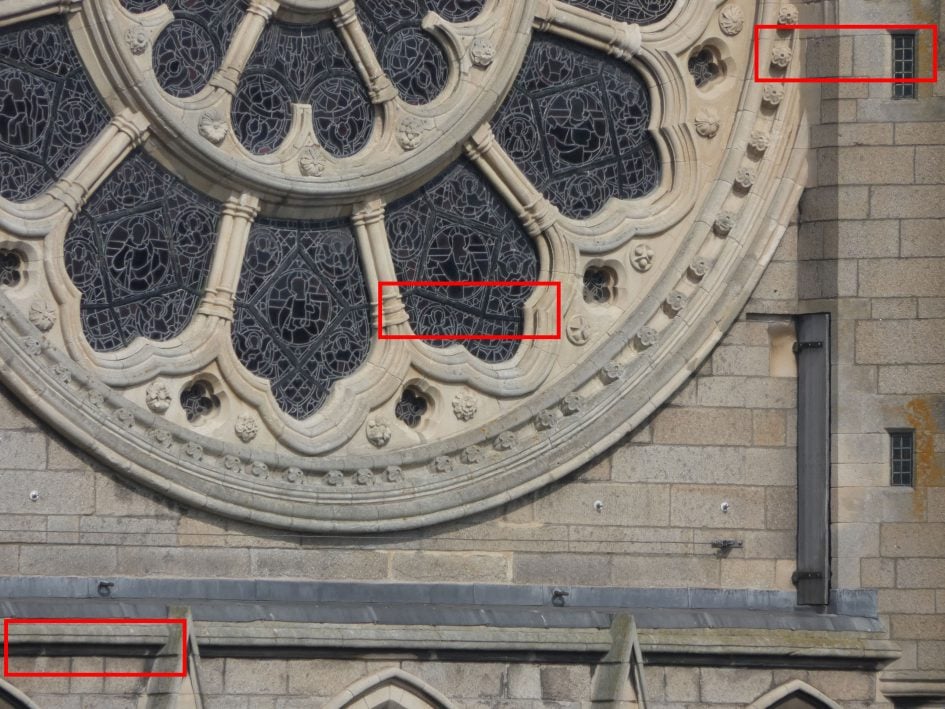
Fully zoomed in to 1200mm I’ve once again taken three crops – two from the corners and one from the middle of the frame. The lens manages very well at the longest focal length, but there’s a slight clumpiness which is obscuring some of the finer detail and scruffing up the edges. The story here is the same as at the other two test focal lengths, apart from some mild distortion and fringing at the widest angle setting, the Lumix FZ80 / FZ82’s zoom lens is a solid performer throughout the zoom range and resolves a good level of detail across the frame. Its good work is let down a little by a sensor that displays noticeable noise artifacts even at its base 80 ISO sensitivity setting.

Above: Panasonic Lumix FZ80 / FZ82 JPEG f5.9, 80 ISO.

Above: Panasonic Lumix FZ80 / FZ82 JPEG f5.9, 80 ISO.

Above: Panasonic Lumix FZ80 / FZ82 JPEG f5.9, 80 ISO.
Panasonic Lumix FZ80 / FZ82 JPEG noise
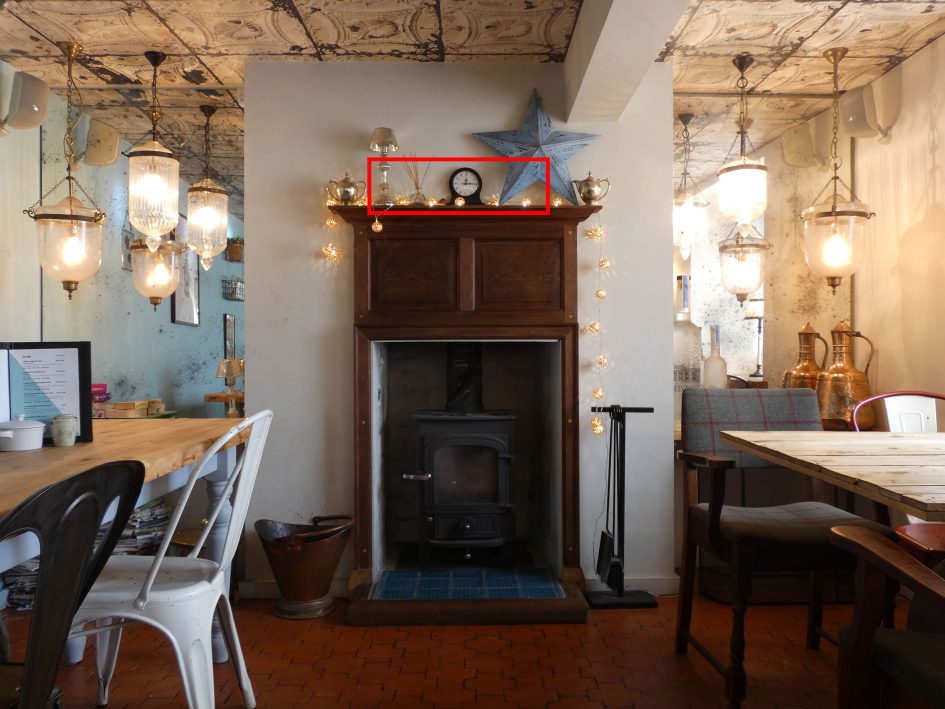
To compare noise levels under real-life conditions, I shot this scene with the Panasonic Lumix FZ80 / FZ82 at each of its ISO settings. The camera was set to its best quality JPEG mode and mounted on a tripod and stabilisation was disabled.
The Lumix FZ80 / FZ82 was zoomed in slightly and the ISO sensitivity was manually set to the lowest available setting. I set the Lumix FZ80 / FZ82 to Aperture priority mode and selected the widest available aperture which was f3.2. At its base sensitivity setting of 80 ISO the Lumix FZ80 / FZ82 chose a shutter speed of 1/5s. As usual, the crops are taken from the area marked in red above.
You don’t have to look too hard to see there’s evidence of noise in the Lumix FZ80 / FZ82 crops right from the off. In the 80 ISO crop, the first one in the series below, it’s most obvious in the clock face where it’s rendered the numerals a bit fuzzy. There’s also quite a bit of texture in the flat colour of the wall and, come to that, just about everywhere else.
To put it into context, you’re unlikely to notice these noise textures at smaller sizes but, as we saw in my outdoor quality test, the noise at the base 80 ISO setting is bad enough to take the edge off image sharpness and obscure finer image detail.
With noticeable noise appearing at the base ISO setting it’s only going to get worse as you progress up the sensitivity scale. And although 100 ISO isn’t much of an increase, the noise here is noticeably worse, though it’s worth repeating the caveat that this is only a big issue if you’re viewing on a large screen or making big prints.
The noise increases at 200 and 400 ISO are small, but significant, and by 800 ISO the cumulative effect is enough to have quite a serious impact on the image detail. This is about as far as you’ll want to go if you’re printing or viewing images at close to 100 percent. But at smaller sizes, like the 945 pixel-wide image of my noise test scene above, you’ll get away with 1600 and even 3200 ISO. The 6400 ISO sensitivity setting is probably best avoided for all but those must have at all cost low-light shots.
Finally, it’s worth a reminder that, all other things being equal, with a bright f2.8 maximum aperture the Lumix FZ80 / FZ82 will let you choose a slightly lower sensitivity setting than much of the competition including the Canon PowerShot SX60 HS and Nikon COOLPIX B700.

Above: Panasonic Lumix FZ80 / FZ82 at 80 ISO

Above: Panasonic Lumix FZ80 / FZ82 at 100 ISO

Above: Panasonic Lumix FZ80 / FZ82 at 200 ISO

Above: Panasonic Lumix FZ80 / FZ82 at 400 ISO

Above: Panasonic Lumix FZ80 / FZ82 at 800 ISO

Above: Panasonic Lumix FZ80 / FZ82 at 1600 ISO

Above: Panasonic Lumix FZ80 / FZ82 at 3200 ISO

Above: Panasonic Lumix FZ80 / FZ82 at 6400 ISO
Next check out my sample images or skip back to my verdict using the tabs above.
Check prices at Amazon, B&H, Adorama, eBay or Wex. Alternatively get yourself a copy of my In Camera book, an official Cameralabs T-shirt or mug, or treat me to a coffee! Thanks!




